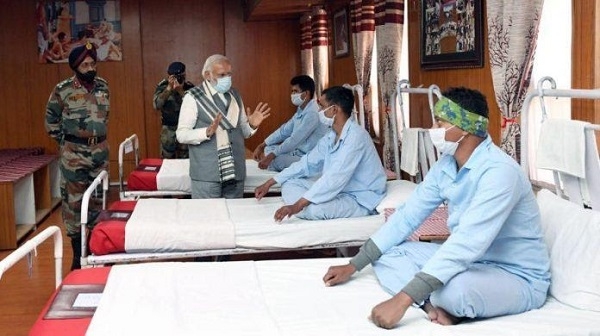Spare the Military: it is no ‘Fakery’
Total Views |
I am the wife of an army veteran, who commanded his regiment in the Kargil-Siachen Sector, a couple of decades ago. Time has flown, but the attachment to the Olive Green runs deep. So, it was with a deep sense of anguish, that one read the malicious post regarding Prime Minister Modi's visit to Military Hospital Leh, doing the rounds on WhatsApp. While an official clarification has been issued, it is indeed a painful fact that the need arose for the army to give an assurance that there was no ‘fakery’ – a term used in the post, in the photographs that showed the Prime Minister's interaction with the convalescing soldiers.

Sadly, it is the combination of scheming anti-national elements and the sensation-hungry social media that is responsible for the sordid ongoing campaign to discredit the military. Wood panels in the ward, absence of a visual display of monitors and oxygen cylinders, and saddest of all, the erect and dignified posture of the wounded soldiers – everything has been questioned. The army had to clarify that the wounded soldiers had been accommodated in an audio-visual hall of the hospital that had been re-appropriated, as all regular wards had been earmarked for Covid patients. A few days earlier, the Army Chief and the Army Commander had also visited the wounded warriors at the same place.
All military hospitals excel in hygiene, cleanliness and orderliness. There is no clutter in the wards. In addition to the doctors, it is the duty of the head of the hospital to visit every ward in the morning to oversee arrangements for patients’ care. All soldiers sit in an erect posture when talking to their seniors. There is even a word of command for the same (savdhan baith). It is a part of their training and comes naturally to them. Even the injured take pride in their soldierly deportment.
It must also be appreciated that the purpose of the Prime Minister’s visit was to applaud the bravery of the soldiers, boost their morale and assure the Indian armed forces of the government’s unstinted support. Such visits are not only symbolic in nature but serve a much wider objective. They demonstrate the government’s determination to face up to a treacherous enemy and strengthen public resolve.
It is imperative that we, as a nation, realise that the armed forces should not be embroiled in controversies, most of which are created with dubious political motives in mind. Have we fallen so low that we need to question the very organisation that safeguards our lives by sacrificing its own, or seek explanations from those who keep vigil in the most inhospitable battlefield of the world?
The armed forces are increasingly being viewed as the sole guardians of matters that concern national security. Soldiers’ dedication to duty, loyalty to the nation and willingness for the supreme sacrifice are driven less by material considerations and more by an overwhelming urge to earn love and respect of their countrymen. They draw strength and sustenance when society views them with a similar perception. Being aware that their image in the society is dependent on media projections, they tend to be very sensitive to adverse publicity and undue criticism. Let us not demean their stature by propounding unfounded and biased views.

